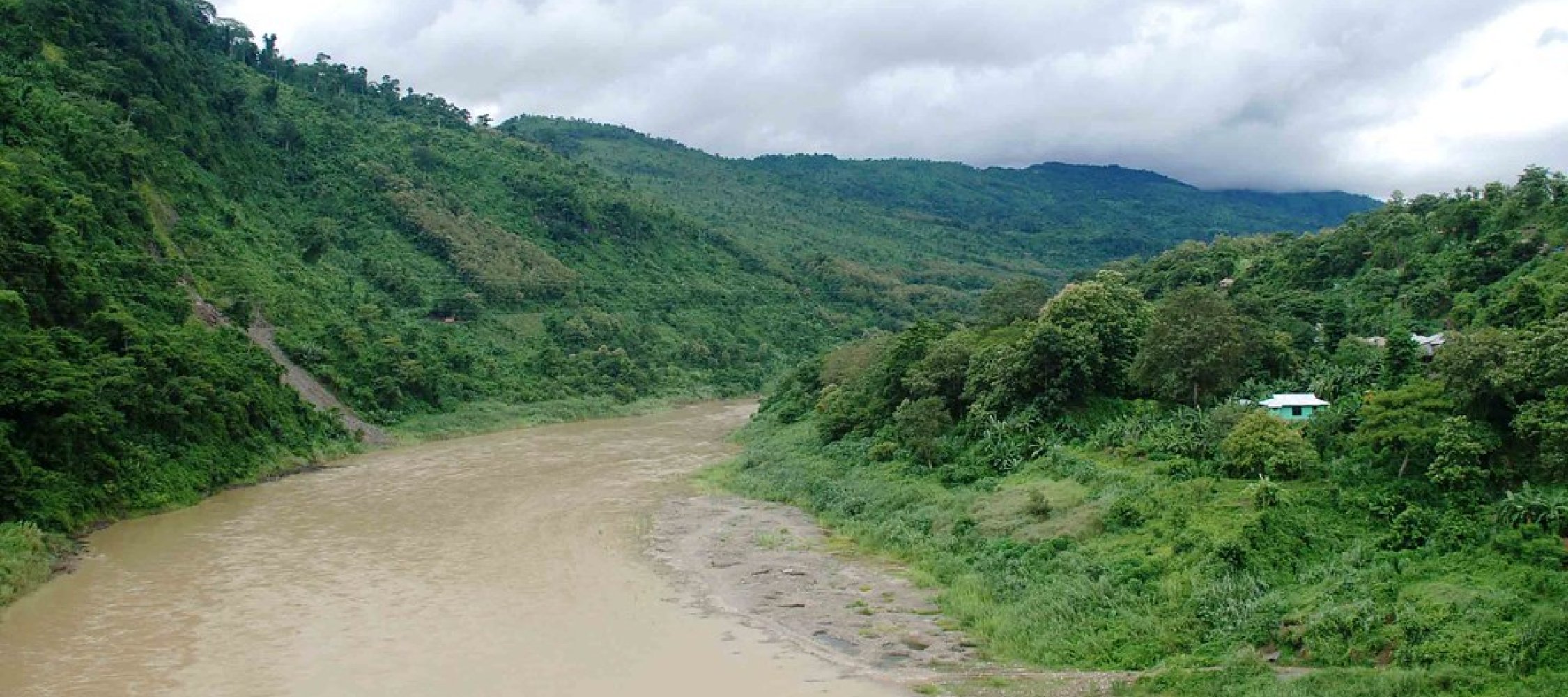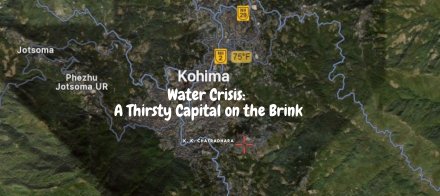 |
Come September-October every year, the tribes-people in the remote corners of Mizoram get busy keeping vigil on the neighbourhood brooks, streams, and rivulets that trickle down the shadowy slopes of the high rugged mountains. Vanguards are sent further downstream to keep a closer watch for the annual visitors. After days of keeping a lookout, there is jubilation as the first cries ring out across the hills, “They’re here, they’re here!”
What they are hailing is an absolute sight for sore eyes and a wonder of nature that very few are privileged to witness. Thousands of schools of fish can be seen struggling up the streams against the flow of water. They throw their bodies on the stones and rocks and keep climbing up, inch by inch. There are thousands of them, all climbing on top of each other as they dart ahead to keep their date with nature to lay their eggs at an appointed time known only to them on the shallow waters among the beds of stones and rocks where the eggs will be safe till they hatch. While there is not much research on this, they seem to have traits of the migratory fishes, which come back to lay their eggs to the same remote mountain streams they were born in and then go back downstream. This is an inbuilt instinct in some of the fish species that guides them in their cycle of reproduction and keeping alive the species. If these waters disappear for whatever reasons, given deforestation, which accompanies the advancing globalising societies, these endemic mountain fishes would simply become extinct. What this loss would mean for the ecology of things can only be imagined as the connections between these fish and the other fishes in the bigger rivers and oceans is quite unknown. Mizoram seems to be one of the few locations on earth where this exciting scene of nature renewing itself in its secret places can be witnessed by the human eye. “They come here to breed. Once they lay their eggs, they go back down to their normal places of inhabitation downstream and maybe in the bigger rivers too,” explained Lalnunpuia, president of the newly formed nature conservation organisation, Wildlife and Environment Protection Society (WEPS) based in Saitual. Saitual is the headquarters of Saitual district, which is about 86 km from Aizawl, the capital of Mizoram. He said the months of October-November were the spawning season of these indigenous fish species. The fish come in such numbers that if a person wants, they can step into the water and start gathering the fish with their bare hands as the fish do not notice anything during this time.
He said local people had been guarding these places to keep the fishes safe during the season. “The fishes are so intent on their destination that they are not at all afraid of anything. They can easily be spaded up and collected. People used to do that. But for many years now, we have been guarding these places,” he said.
He said if left unguarded, there was always the chance that unscrupulous people would simply haul them away in sacks to make some quick bucks. When the season arrives, these families of fishes all congregate towards their spawning grounds. He, however, felt that unlike what some might think in terms of the famed run of the salmon migrations, most of these fish species here did not migrate over long distances. But since there is no study ever being done on the subject, one cannot say for sure.
Lalnunpuia said they had felt the acute need to set up such an organisation as they were located in one of the biodiversity-rich spots in the area where they have some of the most important protected lands in the entire state, such as the Tawi Sanctuary, the Lengteng Sanctuary, Chalfilh, and Bomrang mountains and where the major rivers of the state such as the Tuirini, the Tuivai, and the Tuivawl flow through. “Our first task is to ensure that our forests remain intact so that the rest of nature will be safe. Without the forests, where will our water come from? For sure, these streams and springs will dry up and die if these forests are not there anymore. And then what will happen to our animals and our fishes? We have taken a renewed stand to protect them,” he said. He said the first task that the newly formed organisation has at hand is to help in the community efforts to guard the spawning fish.
Across the length and breadth of the state, such scenes are played out in the hidden waters, in the deep upper mountain ravines, and near the water sources. These tiny streams are the breeding sites where these fishes come to spawn.
A shared video shows the Hmunzawl’s portion of the Tuichang river; the tiny tributaries upstream look black with the fishes climbing over each other to get a place to lay their eggs. The water is almost drowned out under the weight of their numbers. Here the local branch of the Young Mizo Association (YMA) has organised duty groups that guard these precious locations day and night. The YMA is the most influential community-based organisation among the Mizo people, with branches in each town, locality, and village across the state and outside wherever there happens to be a group of Mizo tribes-people. One of its main objectives, among others, is to safeguard the environment, guard forests and waters, protect wildlife and ensure their regeneration.
Lalhmunsanga Hnamte, the principal of the Khawbung Higher Secondary School and a member of the Khawbung YMA, is one of those who is often a part of such duty groups. “Yes, we went to Tuipui and Vawmkhum streams, but this year I did not personally see the spawning, but the fish came, laid their eggs, and disappeared to wherever they came from. This year there was no attempt by anyone to collect the fish. Maybe people have become more caring about nature. Maybe they realise that if we disturb these fishes during this breeding season, there will be no fishes in our rivers in the future,” he said. He said the Tuipui Tlawhchhan Joint Committee, a joint committee of YMA branches from the neighborhood villages, had distributed responsibilities on guarding the fish from people as well as wild animals, and they were keeping a watch across the forests braving the severe winter cold. These YMA branches are from Biate, Khawbung, Tlaikuang, Sailulak, Zawlsei, and Khuangthing. Khawbung is a big village in the Champhai district and also a block headquarters. It isabout 70 km away from the Champhai town. There are 25 villages under Khawbung block. They lie between the river Tuipui and the river Tiau that have numerous tributaries flowing down the mountains, which are the natural spawning grounds of the indigenous fishes.
He said the majority among the species of fish that spawned here were wild betta fish locally known as nghalim, which grew to about six inches in length. Larger fish species such as lengphar also spawned here, but at the confluences where the tributaries meet the bigger rivers downstream, he said.
Mizoram can claim to be one of the few places on the globe where the mountain ranges run north to south. Starting from the border of Assam in the north with which it shares a few kilometres, it is wedged into Myanmar and Bangladesh; the Mizoram landmass on its eastern length runs along the international border with Myanmar, and on the western side, its rugged mountains fall into the plains of Bangladesh. This vantage point between the hill and the plain regions gives Mizoram a unique geography and makes it a biodiversity hotspot with the reach of its water systems traversing across the neighbouring expanse of the Indian, Bangladesh, and Myanmar region, thus making its location an exclusive confluence of the life-bearing waters of three countries.
Geographers have noted that “most of the drainage line originated in the central part of the state, and flow either towards north or south directed by the north-south trending ridges. The valleys are narrow and have been carved out in softer formations. The rivers at various places formed deep gorges and cut across the striking ridges forming water gaps. The upper courses of the rivers are often intervened by waterfalls. As the drainage course is controlled by parallel ranges, the drainage of ephemeral and consequent types show trellis, dendritic as well as parallel drainage patterns.”
Rintluanga Pachuau’s book, “A comprehensive geography of Mizoram,” says that the longest river of Mizoram, Tlawng, and the rivers Tuirial and Tuivawl drainage connect to the Barak basin system as it flows into the Barak valley in the Cachar plains of Assam.
On the western borders, the Khawthlangtuipui begins from the southwestern part of Mizoram, originating in Saithah village in Mamit district. As it flows southward, it forms the boundary line between India and Bangladesh. After running about 128 km, it turns towards the southwest entering Bangladesh through Tlabung, a sub-divisional headquarters, where it is known as Karnaphuli. It flows into the Bay of Bengal near the Bangladesh city of Chittagong.
Khawthlangtuipui has numerous important tributaries such as the Kawrpui, Tuichawng (108 km), and Phairuang, which associate it from the south. The rivers Kau and De flow parallel to it from the south for a considerable length.
Kolodyne, a major river of Mizoram, originates in the Central Chin state of Myanmar as the Timit flows south and eventually into Mizoram, joining the Tiau river, which sources from the northeast corner near Khuangphah village. It becomes the international border of India and Myanmar. It continues to flow northwest into Mizoram as the Kolodyne and further south into the state through the Saiha and Lawngtlai districts, also known as Chhimpuitpui. It flows back into Myanmar in Rakhine state and finally into the Bay of Bengal at Akyab in Sitwe. The Chhimtuipui has major tributaries like the Mat, Tuichang, Tiau and Tuipui.
Here, on the southeastern border, one comes across examples of trans-international border community conservation of biodiversity as people-to-people engagements are made to protect the sangha fuan or spawning fish along the Tiau and its tributaries. One such is the understanding between the federation of YMA branches of several villages in the area known as the Tuipuiral Group YMA, Sub Headquarters Group YMA, and the Joint YMA of Leisenzo, Lianpui. Bulfekzawl, Sesih, etc. The Chin National Army (CNA), an armed organisation based in the Chin State of Myanmar, keeps away unscrupulous hunters, fishers who bomb the rivers and those who want to haul away the spawning fish during the season.
The movement to protect the fishes during the breeding season started about a decade back. It can be attributed to the YMA’s decade old ongoing campaign to get people to protect the dwindling forests, rivers, environment and wildlife. The riverine and aqua-life has been disappearing over the years, with reports saying that many might go extinct if not protected. Now the state government has come forward to support these community efforts by legislating appropriate laws and regulations, including punishment for persons disturbing the fishes during the breeding season.
According to C. Zonunsanga, president of the Centre for Environment Protection (CEP), a premier environment protection organisation based in Aizawl, the last 10 years of such community movement to protect the river fish is paying dividends as water life is returning to many streamlets and rivers now.
With these numerous natural breeding spots still being safe havens for the wild fishes, Mizoram can claim to be one of the few places on the globe where this natural cycle continues, more or less undisturbed. These sites were fabled tales in ancient times, but now due to the expansion of human habitats, these secret places of nature now lie exposed to the whims of humans. Zonunsanga said a lot of research was required on these fish and their habitats and particularly their link to the rest of the species in the adjoined waters. It is also important to find out whether these mountain rivers were actually the natural spawning grounds of the big river fishes in the plains where some studies have theorised that these have lost their natural spawning grounds, which used to be in the hills now cut off due to rivers being choked by dams and other kinds of infrastructure development.
It is equally important to note that Mizoram’s lands and forests are in deep distress because the regulations are not being implemented by the authorities. Worried about the future of Mizoram’s forests, he said, “Whatever little that is being done to protect the waters and the forests are being done by the YMA and the village councils out of their own commitment to the cause. But otherwise, there is a total absence of work culture. The regulations and the laws are not implemented. The legal framework is there, but the management is absent. If this kind of attitude towards protecting our nature continues, very soon we will have nothing to pass on to our future generation. I only hope that people wake up before it is too late.”


